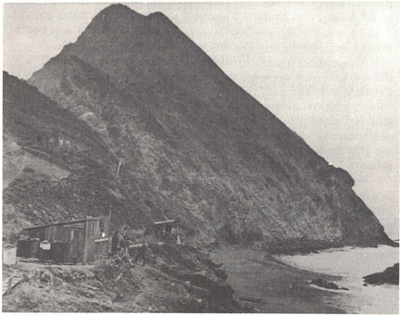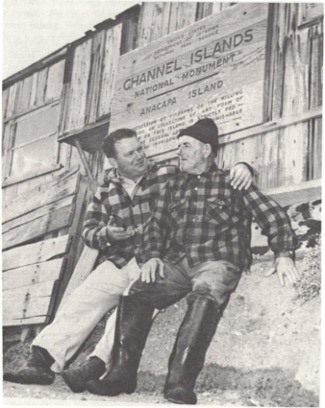By Karen Jones Dowty
Next in our Journal Flashback series is an article from MVC Quarterly Volume 23, Issue 3. Written in 1978 by Karen Jones Dowty, this story recounts the bittersweet tale of Raymond Ledreaux. The beloved Frenchman, who was affectionately nicknamed “Frenchie” by locals, lived out much of his life on Anacapa Island. Frenchie tragically lost his wife during the 1918 flu epidemic and by all accounts never remarried. His story touches on the joy of love, the grief of losing a loved one, and the hope of happiness even after loss. Given that this past Valentine’s Day took place amidst a similar global pandemic, we can draw parallels between Frenchie’s story and our present. We hope that you enjoy and find solace in this tale.
Little is visible from the Ventura County coastline in the gray month of June. An occasional boat or gull may pass; but the Island of Anacapa, only 11 miles from the coast, cannot be seen at all. When the dry east winds have cleared the air of moisture in the autumn, this seaward portion of Ventura County looks close enough to touch.
It was on this rugged island, only a square mile in size, that one of the county’s more colorful residents lived as a hermit. Few people knew his real name. Simply called Frenchie, he came to settle in the shoreward cove which now bears his name. Not at all the proverbial recluse, Frenchie welcomed all visitors to his sheer rock-walled home and enjoyed frivolities, gallantries and lengthy discussions on almost any subject shared over a glass or more of “vino”.
Named Raymond Ledreaux, he was born in Brittany over a hundred years ago. He studied for the priesthood but was never ordained. Disenchanted and bitter towards his church, Ledreaux chose the life of the sea, travelling on merchant vessels to China and America. In San Pedro, California he met his future wife Emma. He and the love of his life had a few short years together. Three children were born. The flu epidemic of 1918, which killed so many, took Emma also. Filled with sorrow over her death, Frenchie searched for a life elsewhere. He tried living in Mexico and lobster fishing there. His grief not subsiding, the Frenchman sought solace in solitude and drinking wine. He moved north to the Channel Islands and finally settled on Anacapa in 1928.
At the cove where tidepool visitors now land, he made his home. Frenchie’s huts were among the sunflower trees called Coreopsis. One shanty was his sleeping quarters. Another housed his gear: odds and ends collected from the cove beach, and materials to repair his lobster traps and skiffs.
A third shack, perched on the rugged cove hillside, was used for guests. Nearby sat drums for the rainwater Frenchie collected because Anacapa is an island without fresh water. People from Port Hueneme to Santa Barbara came to know Frenchie. His cook hut was a favorite gathering place for local fishermen and divers. In his customary red flannels and a three-day stubble on his face, Frenchie would be stoking the fire from a wood pile that housed his colony of semi-wild cats. Beer and wine would be passed around. The sea stories would start and so would another day in Frenchie’s Cove.
Frenchie lived, as the island Indians had for hundreds of years, off the bounty of the sea. With traps he made from wood and wire and using empty wine bottles as floats, he caught lobster. The volcanic undersea terrain and the prolific kelp beds provided Frenchie with a never-ending supply of food. From one of his two heavy skiffs he fished the waters around the small islets of Anacapa. He rowed to other coves to collect abalone. Always he had spare seafood on hand; and on any weekend outing to Anacapa, Ventura County residents would take along a spare jug of wine to trade for some of Frenchie’s catch.
Local coastal families enjoyed their vacations camping near Frenchie’s huts. They would bring him canned goods, bread, cheese and wine and water when he needed it. With supplies provided by the fishermen’s wives, Frenchie would prepare his personal variety of bouillabaisse and other succulent seafood dishes. When the visiting children tired of fishing and playing in the colorful tidepools, they were always glad to return to camp to hear a story or two by Frenchie. Although alone most of the time on an otherwise uninhabited island, Frenchie never lost his love of what he thought were the finer things in music and literature. A discussion of Les Miserables could occur just as likely in Frenchie’s cook hut as in a Santa Barbara drawing room. The smallest audience was all that was required to prompt Frenchie to sing favorite arias in his fine tenor.
As the years passed, Frenchie’s sorrow over the loss of his wife did not lessen and his wine drinking increased. Rarely did he go to the mainland; and then only for short visits to friends he had made while living on Anacapa. All who knew him loved him. He was kind and gentle to children, and they delighted in visiting the French gentleman on Anacapa. Women responded to his gallantry by bringing gifts from ashore. As his wine consumption increased so did his gallantry, but never was an unkind word heard from him.
Frenchie was 68 in 1954. The National Park Service personnel in charge of Anacapa, part of the Channel Islands National Monument, decided to move him ashore. So ended Frenchie’s stay on that craggy, sea-girdled segment of Ventura County. Longtime friends from Port Hueneme bade him good-bye as he boarded the bus for Santa Barbara. His destination was not known and that was the last they ever saw of him.


